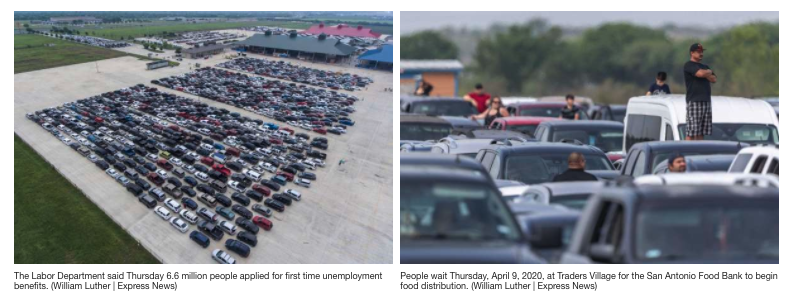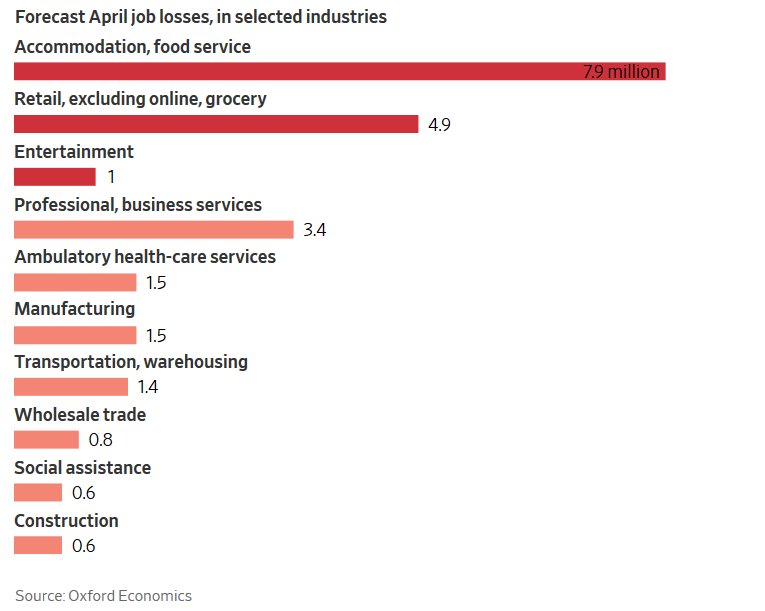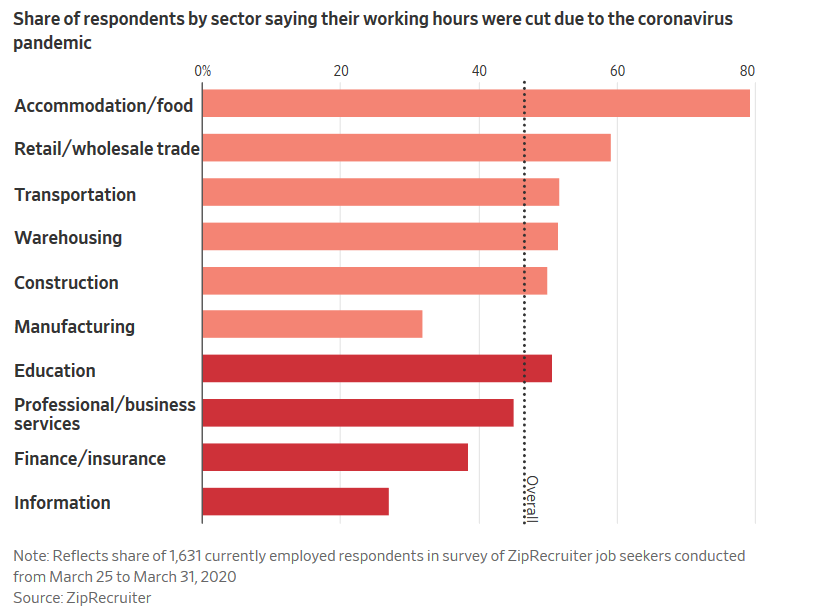 By Tyler Durden
By Tyler Durden
When the United States went into a virtual lockdown to slow the spread of the coronavirus pandemic, the effects were devastating. Within a three-week period, nearly 17 million people have filed for unemployment, while modern-day ‘bread lines’ are getting longer each day across the country.
The initial victims of the lockdown were the most financially vulnerable; restaurant workers, retail employees, and other low-paying jobs in industries which were immediately impacted by a lack of foot traffic.
Now, a second wave of layoffs is hitting those who thought they were safe, according to the Wall Street Journal. White collar workers working from home are being laid off by companies suffering from dismal sales. Law firms are cutting hours and eliminating positions as court systems and legal actions have ground to a near-standstill. And government who assumed their jobs would be safe are being furloughed amid city and state budget shortfalls. Even healthcare workers who aren’t directly fighting the pandemic are finding themselves without work.
And according to the Journal, there’s more pain in the cards.
The consensus of 57 economists surveyed this month by The Wall Street Journal is that 14.4 million jobs will be lost in the coming months, and the unemployment rate will rise to a record 13% in June, from a 50-year low of 3.5% in February. Already nearly 17 million Americans have sought unemployment benefits in the past three weeks, dwarfing any period of mass layoffs recorded since World War II.
Gregory Daco, chief U.S. economist of Oxford Economics, projects 27.9 million jobs will be lost, and industries beyond those ordered to close will account for 8 to 10 million, a level of job destruction on a par with the 2007-09 recession.
Oxford Economics, a U.K.-based forecasting and consulting firm, projects April’s jobs report, which will capture late-March layoffs, will show cuts to 3.4 million business-services workers, including lawyers, architects, consultants and advertising professionals, as well as 1.5 million nonessential health-care workers and 100,000 information workers, including those working in the media and telecommunications.
“The virus shock does not discriminate across sectors as we initially thought,” Mr. Daco said. –WSJ
And where jobs haven’t been lost, hours have been reduced across many sectors:
Tales of economic chaos
The Journal interviewed a diverse sampling of professionals, who shared what they’re seeing within their industries.
See: 177 Different Ways to Generate Extra Income
“Customers who paid like clockwork for 10-plus years are suddenly late,” said Gary Cuozzo – owner of Connecticut-based web host and developer, ISG Software Group, who says he’s received just a few hundred dollars in accounts receivable in recent weeks from customers which include manufacturers, retailers and nonprofits.

Gary Cuozzo, owner of ISG Software Group, stopped drawing a salary to keep his business afloat.
Cuozzo says he stopped drawing a salary several weeks ago and has filed for unemployment – ‘essentially volunteering’ while working from home so his business can remain afloat.
“We have no software projects,” he said. “Everything is on hold.”
Those employed in industries where working from home is feasible are facing widespread layoffs, said ZipRecruiter labor economist Julia Pollak. The recruiting site itself laid off more than 400 of its 1,200 full-time employees at the end of March.
A survey of visitors to the job-search site found 39% employed in business and professional services reported they were laid off, nearly the same rate as respondents in retail and wholesale trade. (Active job seekers are more likely to be laid off than the average American.) Among the respondents who still had jobs, many in white-collar industries said their hours were cut. –WSJ
“Any company that had been planning to open a second location, that hired an architect, an office designer, and contractor—they’re not opening that location this year and those people now won’t have jobs. Any company planning to go public this year, that hired accountants, consultants, PR professionals—they’re laying off all those teams,” said Pollak, the economist.
Hospitals have been cutting elective surgical procedures and routine care across the country in order to free up resources (while many have been filmed virtually empty, and nurses have enough time on their hands to make tiktok videos all day).
“In a sense we kind of sacrificed that revenue for a public-health interest,” said Manchester, NH cardiologist Daniel Philbin of the New England Heart and Vascular Institute. “The hospital systems really are facing an incredible crunch because of this—the longer the curve gets pushed out, the more they face difficult decisions about employment.”
Emily Hill thought her job as a dental assistant was safe, being in an in-demand field and employed through the military. She worked as a contractor at a dental clinic on Fort Hood in Texas.
“I always felt untouchable,” she said. “This really puts you in your place.” –WSJ
Law firms, meanwhile, have been cutting staff and slashing pay due to a stark lack of business, as courts are virtually paused and new deals – which typically require lawyers – just aren’t happening.
“Law firms are not going to be the top of the priority,” said Timothy Lupinacci – CEO of 700-layer firm Baker Donelson, which has some 20 offices in the Southeast and mid-Atlantic region. They’ve reduced compensation for staff and associates by 20%.
Meanwhile, New York City-based Cadwalader, Wickersham & Taft LLP, a 400-attorney firm specializing in financial services has slashed salaries by 25% – and partners aren’t currently getting paid at all.
Economic analysts, meanwhile, are basically all over the place when it comes to predicting when the labor market will bounce back, as it all depends – of course – on when this much-promised vaccine will materialize, and when the economy can ‘open back up’ successfully.
The biggest wild card in the jobs outlook is how long it will take for jobs to bounce back, which depends heavily on how long the pandemic and social-distancing measures last. The consensus among the economists surveyed by the Journal is for employment to return to its February 2020 level in 27 months, but views varied widely.
Economist Amy Crews Cutts, of AC Cutts & Associates LLC, expects the labor market to take 5½ years to fully bounce back. The sheer scale of job cuts so far, even if they don’t worsen further, are “an extraordinary number of jobs to reverse and put back into the economy,” she said.
Still, post-lockdown prospects aren’t great either according to some – as many industries are going to enter their own cyclical recessions (or worse).
“Industries that are subject to cyclical cycles, like finance, real estate and manufacturing, are likely to have layoffs,” said Moody’s Analytics economis Adam Kamins, who thinks that about half the jobs lost to the pandemic will be regained by the end of the summer.
“The lockdown may be over, but there’s likely to be a prolonged period of stagnation.”
Read the rest of the report here.
Source: ZeroHedge
Subscribe to Activist Post for truth, peace, and freedom news. Become an Activist Post Patron for as little as $1 per month at Patreon. Follow us on SoMee, Flote, Minds, Twitter, and HIVE.
Provide, Protect and Profit from what’s coming! Get a free issue of Counter Markets today.
Second Wave Of Coronavirus Layoffs Claiming Workers Who Thought They Were Safe



